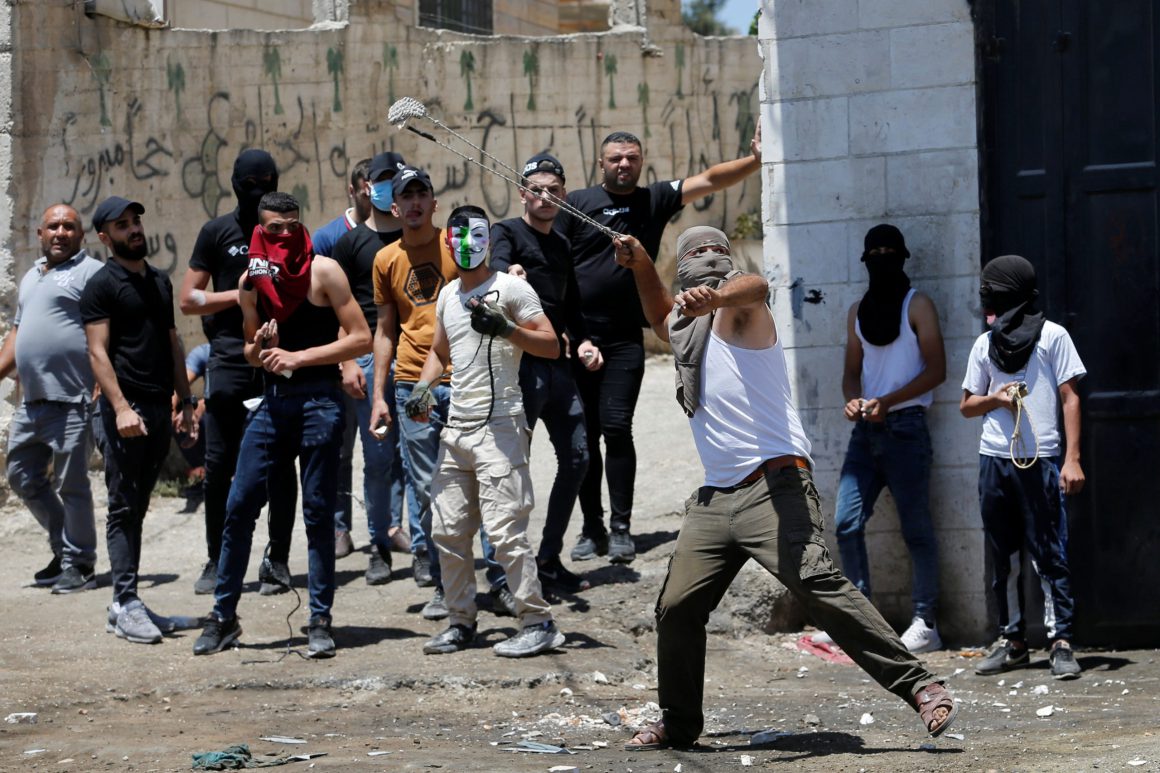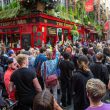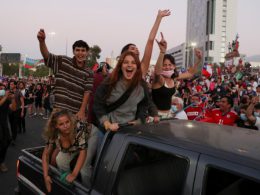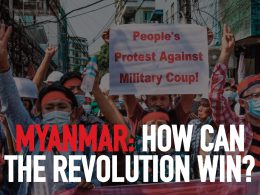By Shahar Ben Horin, Socialist Struggle Movement (ISA in Israel/Palestine)
12-year-old Muhammad al-`Alami, was shot to death by the Israeli army on 28 July while sitting in a car with his dad in the town of Beit Ummar in the occupied West Bank. During his funeral, Israeli soldiers killed Shawkat `Awad, 20. Both funerals saw thousands of residents courageously facing the armed invaders and greeting them with a relentless barrage of stones. This is not an isolated insurrectionary defiance. The West Bank is the current epicenter of a still developing ferment of Palestinian popular resistance. This revolt is led by youths, who also independently initiated and organize ‘night confusion’ actions, with smoke, noise and laser beams deployed in an organized manner against Israeli settlement outposts. In parallel, in Israeli jails, 17 Palestinian administrative detainees, held without trial or charge, have been on a hunger strike.
A day before Muhammad, it was Shadi Salim, 41, who was shot to death, while walking in a field near the village Beita. Earlier, in Nabi Salah, Israeli soldiers killed Muhammad al-Tamimi, 17. Then, Yousef Nawaf Mouhareb, 17, succumbed to his wounds in hospital after originally being shot on 14 May, when at least 11 Palestinians were killed by occupation forces in the West Bank. Brutal demolition of Palestinian houses has continued, and in July, in the C area of the West Bank, two Palestinian villages, Ras a-Tin and Humsa–al-Bqai`a, were raided and demolished. Dozens of children were thrown out of their homes.
This is part of the reality on the ground since the new Israeli “Government of Change” took office on 13 June, in a last moment political upset, deposing Netanyahu as prime minister after 12 years. Three weeks earlier, the ceasefire of 21 May ended the 11-day barbaric Israeli onslaught on besieged Gaza. The new capitalist government of occupation is headed by Naftali Bennet, former CEO of the colonial settlers’ Yesha Council, leader of the small Rightward party, which won 6% of the votes in the March elections. It lost no time in resuming ‘retaliation’ bombings in Gaza and repressing and killing Palestinians in the occupied West Bank. The military repression of protests against a new unofficial colonial settlement, Evyatar, resulted in several killings of Palestinian protesters. The new government soon reached a deal with the settlers to exchange their temporary evacuation for a potential official recognition.
The same government has launched military attacks in Syria and southern Lebanon, as well as seemingly, armed sabotage actions in Iran. Domestically, in an attempt to curb the state deficit, new economic attacks are being prepared against the working class and poor across national communities, although they already face some resistance. On top of it, the Covid-19 Delta variant threatens to challenge the vaccines and, worse, to spread among the largely unvaccinated Palestinian population in the West Bank and Gaza, which was de-facto deprived of vaccines under the Israeli occupation. The Palestinian Authority (PA) aborted a deal with the new Israeli government that was supposed to swap a future shipment in exchange for an immediate transfer of a million doses from Israel — they proved to have nearly expired.
Unabated atrocities and awakened resistance
April and May, around Islam’s holy month of Ramadan, saw a generalized escalation in aggressions by the Israeli state against the Palestinians, starting in occupied East Jerusalem, in Sheikh Jarah, Al-Aqsa, and Damascus gate. They rapidly spilled over, as the Israeli state moved to quell Palestinian popular resistance, and followed to a confrontation with Hamas, which intervened with rockets launched at Israeli cities. In the horrific bombings in Gaza about 250 residents, including dozens of children, perished. In Israel, 13 people, Jewish, Palestinian and immigrant workers, including two children, were killed as a result of rocket fire by Hamas and the Islamic Jihad sect.
In the West Bank, in May alone, 35 Palestinians — the highest monthly figure for a decade — were killed by occupation forces. Cases have been documented of paramilitary settlers’ gangs raiding Palestinian villages openly in coordinated action with soldiers, killing at least four residents. The Israeli far-right has been emboldened through an alliance with former prime minister Netanyahu. A surge in Israeli far-right terrorist actions against Palestinians even prompted a protest letter by former soldiers, demanding the government restrains settlers’ violence.
In the last escalation, the war machine of Israeli capitalism was mobilized once again, ultimately, in order to re-assert the status-quo of the occupation, Gaza blockade, colonial settlements, and at large, the systematic national oppression and expropriation of millions of Palestinians, with aspects of Apartheid. In the context of this conflict, elements of civil war erupted along national lines in the ‘mixed’ cities in Israel, reaching the worst level since 2000, not least with Israeli far-right Kahanist forces mobilized against the Palestinian population.
However, with Trump gone, with an Israeli regime weakened in a quagmire of political crisis, and with a backwind from last years’ new cycle of mass movements in the region, the last round of the Israeli offensive against the Palestinians triggered a militant revolt by Palestinian youth and workers across the Green Line. An incipient uprising developed, the most extensive and generalized Palestinian revolt since 2000. This was completely unforeseen by those believing that the Palestinian struggle was on a long-term downtrend. It aroused global uproar, with solidarity protests around the world and mass mobilizations in the region. ISA took part and intervened in solidarity protests across cities internationally, and its section in Israel-Palestine, Socialist Struggle, intervened in demonstrations on the ground from Sheikh Jarah to Haifa.
Palestinian youths have been boldly challenging the Israeli state forces in the face of repression, which in the West Bank has been highly lethal. Since the ceasefire and following the mass arrests, protests within Israel, within the 1948 borders, receded but at their height, they witnessed youths shooting fireworks towards police forces or climbing street poles in defiance to replace an Israeli flag with a Palestinian one. On social media, youths tactically outsmarted censorship to release voices and images from the fightback on the ground.
An extraordinary all-Palestinian general strike was organized on 18 May, which spread across the Green Line, with picket-lines at the entrance to municipalities and neighborhoods. It far superseded the protest ‘general strikes’ organized occasionally in Arab municipalities in Israel. Despite threats of layoffs and usually the lack of union backing, the strike was a magnificent display of particularly working-class struggle, as many Palestinian workers in Israeli-owned businesses went on strike. Construction sites were brought to a halt. A Jewish crane operator described to Haaretz his inspiration, “if all of us would have fought like this over workers’ rights, we might have achieved something”. While this was a limited single action, it underlined the potential for a higher level of more effective, working class-led Palestinian liberation struggle.
Israeli right-wing ‘Government of Change’
The new Israeli government was born through a political deal by an exceptional, heterogenous coalition of 8 parties, encompassing about half of the Knesset, where it was approved marginally. It was formed under a special parity arrangement, first implemented in the last Netanyahu cabinet, which was a short-lived ‘national unity’ coalition with remnants of ‘Blue and White’ (see below) and Labor at the height of the pandemic. Now it’s used to vest more power in the hands of Bennet’s wing, using a veto power granted to what are merely two small hard-right settlerist parties. Only two parties in the coalition are not former members in Netanyahu’s governments: the ‘Zionist left’ Meretz (including a Member of the Knesset [MK] who unfortunately is a leadership member of the leftist Standing Together formation), and the Islamist ‘United Arab List’ (Ra`am), the first Arab party in decades to officially participate in Israeli government.
Some apologists for the new right-wing government described it as ‘historical’ and a ‘step forward’ for Jewish-Arab relations. This is the reasoning of a section of the Israeli ruling class which is striving for system stabilization by advocating a more inclusive approach towards the Arab-Palestinian citizens of Israel in the political and economic spheres. Clearly, they hope also to curb Palestinian radicalization. But camouflaging the inherent contradiction between a nationally oppressing regime and nationally oppressed population proves challenging. One of Ra`am’s MKs abstained from the vote on government approval, saying he can’t “explain to residents that I’m part of a [government] coalition while bulldozers trample their homes”!
Politicians from the Netanyahu-led rightist opposition sarcastically thanked Meretz and Ra`am for their role in assisting to save the Evyatar settlement. Those two parties have also already managed to vote in favor of renewing 18 year-old racist legislation, which denies Palestinian families unification (denies access to Israeli citizenship or residential status to Palestinians in the West Bank and Gaza who are married to Israeli citizenship holders). The vote was nevertheless defeated, as it was tactically opposed also by Netanyahu’s bloc. Despite this rivalry, the new government is, in the main, a successor of the trajectory of policies implemented by previous cabinets headed by Netanyahu. It was no accident that moments before, the bulk of the ‘Bloc of Change’ had been siding with Netanyahu’s state-terrorist actions in Gaza.
Ironically, this new government, with its ‘leftist’ and Arab fig-leaves, cannot even reiterate the hypocritic stance of Netanyahu’s Bar Ilan speech of 2009, when he paid lip-service to the idea of a Palestinian state. This inflexibility reflects a weakened position for the Israeli ruling class, with a weak government and no clear route for stabilization, in the face of growing instability of the regime of occupation. There have been some attempts from the Israeli government to re-strengthen ties with the PA, in coordination with the Biden administration. But although this government cannot implement the aspiration of Bennet and others for formal annexations, it’s politically incapable of offering any substantial concessions to the Palestinians.
Biden vows to continue Trump’s sponsored ‘normalization’ process between Israel and Arab states. The recent Palestinian revolt and the wave of regional and global solidarity protests undermined and compromised this process. That’s a major factor behind the more rapid ceasefire in comparison to 2014. The Bennet government is attempting to thaw its relations with Jordan and strives for new ‘normalization’ agreements, although those would face stronger pressures for concessions to Palestinian demands.
Internationally, while Israeli capitalism has boasted of stronger relations with many of its counterparts over the past decade, it is faced with growing revulsion among the masses in the region, and a younger radicalizing generation in the US and Europe. The recent revelations on NSO/Pegasus only attracted renewed attention to the infamous spyware and weapons industry of Israeli imperialism. Particularly worrying to the latter is the decline in support among Jewish communities in the US and globally. Whereas religion and state are not separated in Israel, the new Israeli government attempts to implement a more inclusive approach to various non-orthodox religious denominations in a strive to regain support for Israeli capitalism and occupation among Jewish communities abroad. But this is marginal, as their intransigent defense of the occupation and colonial settlements persists.
So, when, following the war on Gaza, Unilever’s ice-cream manufacturer Ben & Jerry’s yielded to years of protest and announced they will require their Israeli franchisee to stop selling in Israeli settlements, the Israeli establishment went berserk. The move was tagged outrageously as anti-Semitic, and described as a “BDS” (‘Boycott, Divestment, Sanctions’) attack against Israeli society — of course, disregarding that the logic of BDS, in contradistinction, targets the whole of Israel, not selectively the Settlements. Such a fierce hysterical demagoguery is necessary for them to de-legitimize Israeli public discussion over the legitimacy of the Settlements, and also, to deter any wave of international boycotts driven under popular pressure.
Systemic crisis delivers a crisis government
The new Israeli ruling coalition, stitched together from an amalgam of available small parties, was born out of a systemic crisis. It follows over two years of a political crisis, with neither of the two bourgeois blocs able to win enough electoral support to form a majority coalition. Netanyahu faced growing opposition, with his corruption trial serving as a focal point, while he shifted to lean more on right-wing Trumpite populism. Throughout his defense campaign, which even invoked the idea of a coup conspiracy against him, he failed in his endeavor to consolidate his bloc.
In 2019, a section of the security establishment and ruling class moved to launch ‘Blue and White’, originally as a broad coalition, headed by former generals and Lapid’s center-right ‘Yesh Atid’ party. Apart from Netanyahu’s Likud, no bourgeois party has maintained a solid sizeable electoral base, so that coalition absorbed even some of Netanyahu’s hard-right former associates. ‘Blue and White’ exploited anti-Netanyahu sentiment and mobilized record votes, but could not form a majority coalition in three general elections in a year, as their pro-capitalist ‘clean politics’ campaign couldn’t win genuine mass enthusiasm. Their split after the March 2020 election, with one wing joining Netanyahu in power, occurred as parts of ‘Blue and White’ rejected the idea of relying on Arab-based parties to secure a majority — a combination promoted by a section of the ruling class as an outlet from political crisis. Under the pressures of mass discontent, the ‘national unity’ government collapsed rapidly and the Likud split.
The March 2021 election, despite rapid vaccinations, saw Netanyahu’s bloc again with no majority, but also a more fragmented rival bloc. This time, Netanyahu’s bloc was desperate enough to itself seek a deal with the Islamist Ra`am, despite earlier depicting this idea as an alleged security risk. In vain. Netanyahu boosted up votes for the far-right to secure his future coalition, but it was they who then opposed entering a minority government that would rely on an Arab party. That barred Bennet’s initial drive for a government with Netanyahu and the far-right.
Influenced by a bourgeois campaign to avoid another election, an unlikely political marriage materialized between the hard-right settlerist parties of Bennet and Sa`ar, and the parties of Ra`am and Meretz. The underlying logic bringing together those parties was of system re-stabilization — each, with its own political deadlock, enlisted to bail the system out of its protracted political crisis, and, at root, out of deeper developing crises and strategic challenges for Israeli capitalism.
But the new ruling coalition sprouted by the system to end the political cycle of Netanyahu’s rule is the most unstable in the state’s history and is incapable of steering the system towards any substantially more flexible policies. In relation to the occupation, but not only. Although several of its member parties earlier advocated expansionary policies, this government has been playing with ideas for austerity measures, to attempt tapering the deficit without touching the capitalists. Even while public debt is at a moderate 73% to GDP. They met pressure from the Bank of Israel, which advocates limited fiscal expansion. But most importantly, they’ve been confronted with a new phase of often offensive struggles by working-class and middle layers. Those have demanded change, including investment, staff, wages and allowances increases in the face of growing inflation. The government retreated on points, although is still pushing a very restrained budget. This allows Netanyahu’s camp to whip up right-wing populism, attacking what it calls a government of the ‘white elites’, allegedly extorted by Ra`am (an implicit racist scapegoating of Arabs). One former Likud minister sarcastically described Labor as “so-called socialist” and claimed that “this is class war”. The government will face more pressures for concessions as it aims to pass an official state budget for the first time since 2018. An intervention from the left, including in workers’ organizations, will be necessary to offer an alternative.
The Joint List, as a left-leaning opposition, correctly voted against the forming of the Bennet government. Ra`am used to be a part of that political alliance, established first for the 2015 election and initially arousing enthusiasm among many Palestinians in Israel. The opportunistic turn of the Islamists to participation in government has been ultimately an attempt to address broad disillusionment with the Joint List. The Joint List became for a time the third largest faction in parliament, but that project, as we warned, was bound to disappoint. It was a subjugation of the left to a bloc based on national unity with pro-capitalist reactionary forces, around a vague democratic program. Its narrow parliamentarist strategy seriously weakened its prospects for leading effective battles. Thus, paradoxically, while the March 2021 election saw a record low turnout of Arab voters, most Arab-Palestinian citizens were sympathetic to the idea of an Arab party participating in government.
The highly right-wing Israeli parliamentary arena, in itself, is a route blocked for decisive gains. But potentially, leftist MKs, with a clear program, could be used to assist the building of powerful movements that could challenge the right-wing regime. The recent upsurge of Palestinian youth and workers’ struggle also within the borders of 1948 have underlined the potential for an effective mass mobilization of the Palestinian minority in Israel. This trend should be further enhanced. At the same time, there’s also a need to advance a political alternative to the right-wing government. A class-based, cross-national community strategy and political alternative is required.
Hamas gains from political vacuum
The Gaza ceasefire is far from stabilized. Bennet’s government is responding even to arson-balloons [party balloons filled with helium or hydrogen with incendiary devices attached] with bombings and tighter restrictions. It has also been stalling the emergency monthly cash inflow from Qatar, which is used to pay electricity, public salaries and grants to poor families. Israel is now attempting to force the Hamas administration to agree to replace that mechanism with a more tightly controlled one.
Pressed by deep crisis, the local Hamas leadership in Gaza, headed by Yahya Sinwar, militarily intervened during the popular revolt in Jerusalem against Israeli attacks, to forge an image for itself as a defender of Al-Aqsa and the Palestinians. It posed as an alleged militant alternative to the Fatah leadership, while Palestinian Authority (PA) weapons are used exclusively against Palestinians. But catastrophic conditions and Hamas’ authoritarian methods have fueled popular discontent and protests in recent years. Hamas failed to lead an effective strategy to overcome the siege, and the pandemic deteriorated conditions. So, divisions have opened in the Hamas leadership, manifested in the internal leadership selection last March, when Sinwar needed four voting rounds to retain his position.
Hamas managed to partially fill the vacuum created by the crisis of Fatah and the PA (controlled by the latter). The cancellation in April of the first legislative and presidential elections in 15–16 years only further undermined the PA, its long-hated president Mahmoud Abbas, and Fatah. They feared the outcome. The imprisoned Marwan Barghouti, the most popular Palestinian leader for years, and nominally a Fatah central committee member, declared he’d be contending independently for presidency. He would have won. Hamas now demands that Israel releases him and others in a proposed prisoner exchange deal.
A splinter Fatah-associated ‘Freedom List’, headed by Nasser al-Qidwah (Arafat’s nephew) and supported by Barghouti, undermined the official Fatah list. In the West Bank, Hamas was likely to gain in the legislative elections. A PCPSR poll in the West Bank and Gaza, early June, underlined increased support for Hamas, although the authors qualify that it’s not “fundamentally different from similar findings we obtained in the past immediately after similar Hamas-Israel confrontations”. If legislative elections were to be held, the Hamas’ list, ‘Jerusalem is Our Call’, would have come out first, with 36%. The official Fatah with 19%, and al-Qidwah’s list with 9%.
77% consider Hamas as ‘winning’ the last confrontation with Israel. Most Palestinians in the territories of 1967 support Hamas retaliating with rockets if Palestinian families are evicted in East Jerusalem, while at the same time believe that Hamas and Israel will now move to reach a long-term truce. This suggests a view that Hamas’ firepower could in itself decisively deter Israeli aggressions. 65% of respondents even believed, incorrectly, that Hamas forced Israel to stop expulsions of Palestinian families in East Jerusalem and restrictions on Muslim access to Al-Aqsa.
The grain of truth is that Hamas’ armed wing, `Izzadin al-Qassam, the strongest Palestinian militia, developed substantially in Gaza despite all past military offensives by Israel. It became more of a factor — following the Shi`ite Hezbollah in Lebanon — for the Israeli regime in calculating scenarios of escalated conflict. It raised the potential costs of Israeli ground invasions, but also demonstrated it is capable of heavily disrupting routine in the Israeli economy, education system and central cities.
However, most Palestinians view Hamas also as corrupt. Hamas could not yield any permanent concession, nor match the advanced firepower of the Israeli military, which every time unleashes mass killings in Gaza. Essentially, Hamas offers no way to bring closer Palestinian national and social liberation. Of course, the Palestinian struggle, coping with deadly oppression, cannot relinquish arms for defense. But to guarantee its potential effectiveness, an armed struggle should be an auxiliary measure, subject to the independent struggle and mobilization of the Palestinian masses, via elected popular committees. The power of mass struggle is a far greater threat to the occupation than any secretive militia. Specifically, Hamas’ indiscriminate fire towards civilians was not only futile but detrimental in stopping Israeli aggression. Hamas’ reactionary program, rhetoric and methods only facilitated the Israeli regime in whipping up security demagoguery to draw support for atrocities against Palestinians.
From the cancellation of elections to impotence in the last escalation, the PA and Abbas further exposed themselves as, ultimately, subcontractors of the occupation, including the infamous “security collaboration”. They doubled down after the ceasefire. An opposition activist, Nizar Banat, from the ‘Freedom and Dignity’ list, who posted popular posts on Facebook, was killed on 24 June at the hands of the PA security forces, which aim to silence critical voices. Through this martyr, they triggered the opposite, an avalanche of rage and protests against the PA in the West Bank, with calls for the resignation of Abbas and chants of the iconic slogan of the 2011 regional revolutionary wave, “the people wants the fall of the regime”.
The despised undercover gangs of the PA for cracking protests were called in to brutally repress opposition. But the subjugated PA, under the rule of octogenarian Abbas, is teetering in a deep multi-dimensional crisis, aggravated by the pandemic and economic sanctions by Israel. US envoy to the Israeli-Palestinian conflict, Hady Amr, reportedly told Israeli officials the PA’s situation “is like a dry forest waiting to catch on fire”. The PA seems to hope that post-Trump US imperialism will pressurize Israel for concessions, but that’s against the background of popular rejection of negotiations with the US and the occupying regime. A new generation of Palestinians sees through such charades, as it’s turning to boldly challenge the occupation, returning to rich struggle traditions and shaping new ones.
For a popular Intifada, for socialist alternative
Palestinian support in the territories of 1967 for the idea of a ‘two-state’ solution remains limited, at around 40%, after years of hollow imperialist promises while Israel continues the rampant construction of settlements. But it is superseding support for the idea of a bi-national ‘one-state’ solution (20%), which is often viewed with suspicion, and not as expressing a prospect of national liberation. Even the ideas of a joint confederation or Jerusalem as an ‘open city’ shared by two states are rejected.
While Israeli capitalism can be forced into concessions to the Palestinians, its interests are vehemently threatened by the very idea of an equal independent state, equality to Palestinians in Israel, and a just solution to the refugees in historic Palestine. US and world imperialism, as well as regional oligarchies, have interests in ties with Israeli capitalism, and not in genuine Palestinian emancipation, which could have an electrifying radicalizing effect worldwide.
The popular and defense committees and the youths at the centers of struggle in the West Bank have been organizing actions under extremely difficult conditions. With some inspiration drawn also from the Gaza protests of 2018–19, they have continued in the face of attacks by the Israeli military and far-right settlers, while suffering a soaring number of martyrs and countless injuries. The recent Palestinian mass actions, with a most courageous collective fightback, and particularly working-class action, recalled scenes from the historic mighty first intifada, and gave again a glimpse to a real way forward to challenge the oppressive Israeli regime. A new popular Intifada, supplemented by the backwind of more regional and world solidarity actions by workers and youth, could inflict serious blows against the occupation and force real concessions. Movements don’t wait for leaderships, but importantly, the mass aspirations for a Palestinian revolution require an alternative independent left, socialist, leadership to the dead-end offered by both Fatah and Hamas, to help build the liberation struggle to its full potential.
Enhancing and building a left alternative in Israeli society is also crucial. Some on the left internationally tend to an ultra-exceptionalist approach to Israeli class society. They portray simplistically the whole of Israeli society as one reactionary bloc. While the national contradiction in society plays a central role, such an over-abstraction ignores the fundamental class divide and important splits in society. But going as far as shutting down the Israeli economy, state and war machine would require substantial mobilization of the Israeli working class and oppressed against the Israeli capitalist machine. There is no other serious strategy to overcome Israeli capitalism, the strongest military power regionally.
National chauvinism in Israeli society (and elsewhere) is indeed a real challenge. Left forces are weak, as they are regionally. This was reflected when, for example, the workers’ committee in the state’s Electricity Company, which earlier this year organized a brief work stoppage to protest femicide, threatened not to collaborate with restoring electricity lines to Gaza. The main responsibility for this is held by the Histadrut’s reactionary leadership, a loyal mouthpiece for the hegemonic chauvinist propaganda spawned by the capitalist press and establishment parties used to “manufacture consent”. It’s no surprise that much of the Israeli population succumbed to the reactionary stance of opposing the ceasefire. But this was also, ultimately, a twisted reflection of eroded trust in the Israeli establishment’s promised solutions to security concerns.
Yet, the Israeli far-right is isolated. When elements of civil war emerged, workers and passers-by intervened in various instances to defend each other across national lines. A wave of solidarity initiatives of Jews and Arabs developed in workplaces, campuses, and communities. It did not go as far as opposing the bombings and occupation, but served as a certain counterweight to nationalist reaction, even in the absence of any strong left force. The aforementioned more ‘liberal’ section of the ruling class also hypocritically advanced initiatives of ‘Jewish-Arab solidarity’ at the height of the crisis, seeking stabilization, but that wave definitely involved spontaneous independent initiatives by bus drivers organized in the ‘Power to the Workers’ union, as well as medical staff, teachers and others. This trend represented buds in the direction of the class solidarity which needs to be built.
There’s a need for a program absolutely guaranteeing Palestinian liberation, while pointing to a genuine solution to the conflict. Facing Israeli capitalism, and its reliance on security and existential fears among millions of the Israelis, there’s also a need to advocate for equal rights for both nations, including self-determination. That’s why ISA advocates an independent, equal socialist Palestine, with its capital in East Jerusalem, alongside a democratic, socialist Israel, with equality for all minorities, as the alternative to Israeli capitalism and Zionism. A collaboration in struggle for a new social system, for socialist change, could enable, via democratic planning and shared resources, the uprooting of poverty and inequality, building of trust among equals, a return of refugees who would so choose, and high living standards for all. As part of a regional and global perspective for a ‘socialist spring’, true national liberation and peace could be established. The recent developments, in the context of trends of revolution and counter-revolution regionally, lay the ground for opportunities to build new struggle formations and the vitally necessary left, socialist forces to offer an exit strategy to overcome Israeli capitalism and its occupation.












